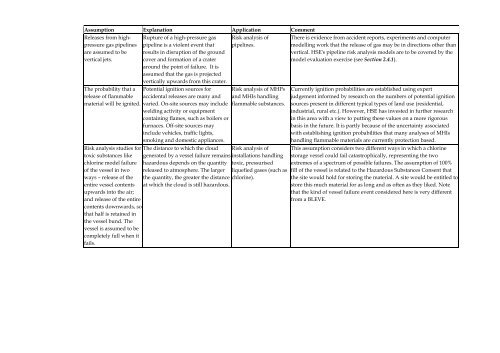A review of HSE's risk analysis and protection-based analysis ...
A review of HSE's risk analysis and protection-based analysis ...
A review of HSE's risk analysis and protection-based analysis ...
You also want an ePaper? Increase the reach of your titles
YUMPU automatically turns print PDFs into web optimized ePapers that Google loves.
Assumption Explanation Application Comment<br />
Releases from highpressure<br />
gas pipelines<br />
are assumed to be<br />
vertical jets.<br />
Rupture <strong>of</strong> a high-pressure gas<br />
pipeline is a violent event that<br />
results in disruption <strong>of</strong> the ground<br />
cover <strong>and</strong> formation <strong>of</strong> a crater<br />
around the point <strong>of</strong> failure. It is<br />
assumed that the gas is projected<br />
vertically upwards from this crater.<br />
The probability that a Potential ignition sources for<br />
release <strong>of</strong> flammable accidental releases are many <strong>and</strong><br />
material will be ignited. varied. On-site sources may include<br />
welding activity or equipment<br />
containing flames, such as boilers or<br />
furnaces. Off-site sources may<br />
include vehicles, traffic lights,<br />
smoking <strong>and</strong> domestic appliances.<br />
Risk <strong>analysis</strong> studies for The distance to which the cloud<br />
toxic substances like generated by a vessel failure remains<br />
chlorine model failure hazardous depends on the quantity<br />
<strong>of</strong> the vessel in two released to atmosphere. The larger<br />
ways – release <strong>of</strong> the the quantity, the greater the distance<br />
entire vessel contents at which the cloud is still hazardous.<br />
upwards into the air;<br />
<strong>and</strong> release <strong>of</strong> the entire<br />
contents downwards, so<br />
that half is retained in<br />
the vessel bund. The<br />
vessel is assumed to be<br />
completely full when it<br />
fails.<br />
Risk <strong>analysis</strong> <strong>of</strong><br />
pipelines.<br />
Risk <strong>analysis</strong> <strong>of</strong> MHPs<br />
<strong>and</strong> MHIs h<strong>and</strong>ling<br />
flammable substances.<br />
Risk <strong>analysis</strong> <strong>of</strong><br />
installations h<strong>and</strong>ling<br />
toxic, pressurised<br />
liquefied gases (such as<br />
chlorine).<br />
There is evidence from accident reports, experiments <strong>and</strong> computer<br />
modelling work that the release <strong>of</strong> gas may be in directions other than<br />
vertical. <strong>HSE's</strong> pipeline <strong>risk</strong> <strong>analysis</strong> models are to be covered by the<br />
model evaluation exercise (see Section 2.4.1).<br />
Currently ignition probabilities are established using expert<br />
judgement informed by research on the numbers <strong>of</strong> potential ignition<br />
sources present in different typical types <strong>of</strong> l<strong>and</strong> use (residential,<br />
industrial, rural etc.). However, HSE has invested in further research<br />
in this area with a view to putting these values on a more rigorous<br />
basis in the future. It is partly because <strong>of</strong> the uncertainty associated<br />
with establishing ignition probabilities that many analyses <strong>of</strong> MHIs<br />
h<strong>and</strong>ling flammable materials are currently <strong>protection</strong> <strong>based</strong>.<br />
This assumption considers two different ways in which a chlorine<br />
storage vessel could fail catastrophically, representing the two<br />
extremes <strong>of</strong> a spectrum <strong>of</strong> possible failures. The assumption <strong>of</strong> 100%<br />
fill <strong>of</strong> the vessel is related to the Hazardous Substances Consent that<br />
the site would hold for storing the material. A site would be entitled to<br />
store this much material for as long <strong>and</strong> as <strong>of</strong>ten as they liked. Note<br />
that the kind <strong>of</strong> vessel failure event considered here is very different<br />
from a BLEVE.

















